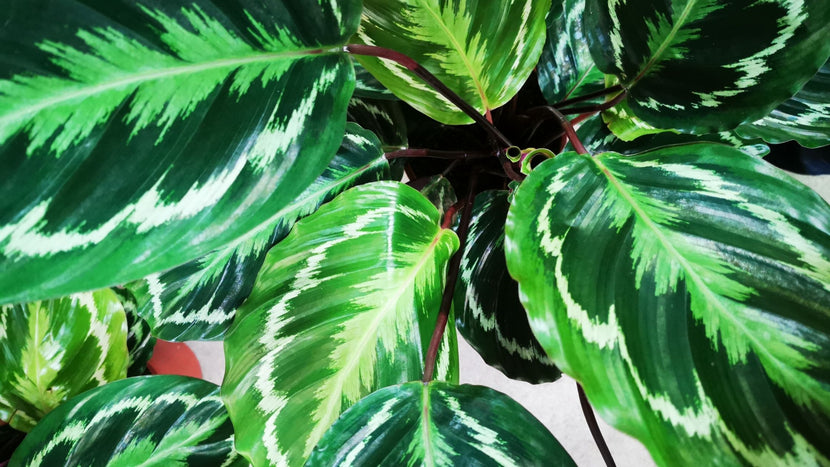How to Care for Calathea Plants
Plant Guide

Calatheas are beautiful indoor plants that have interestingly patterned and colorful foliage. The tops of the leaves are often heavily patterned and often have many shades of green or other colors on the same leaf. The undersides of calathea leaves are often burgundy red or shades of purple.
The exciting leaves have earned calatheas several nicknames such as peacock plant, zebra, and rattlesnake plants. Calathea plants are also called the "prayer plant" as they are closely related to the maranta plant, also known as the prayer plant.
Calatheas grow naturally on the forest floor of tropical rainforests in Central America. Coming from this region, it's safe to assume they thrive in low light conditions but require a humid environment to thrive.
One of the most extraordinary things about this tropical plant is that you will notice that they will move throughout the day. Calatheas have evolved to do this so to capture all the available light that manages to find its way to the densely canopied rainforest floor. Because of this, Calatheas are naturally a low-light plant.
Ground Rules
Light
Calathea plants thrive in low light conditions. They do very well in offices due to the absence of natural light as well as bathrooms and kitchens which tend to receive less natural light. Never situate your calathea in front of a south-facing window as the bright sunlight can burn the colorful leaves of the plant.
Signs of too much direct sunlight will be burnt brown areas on the leaves as well as the dull coloration of the leaf patterns.
Water
Because they naturally grow in the pristine rainforests calathea plants prefer distilled water or filtered water that has been purified in some way to water them. Calathea, like to have evenly moist soil but not soggy soil. They do not want to be over-watered, as this can drown them. When you water a Calathea plant, do not water it so much that the plant ends up sitting in standing water.
Be sure to choose a pot that has drainage holes to allow excess water to drain from the pot. You may also want to place a layer of pebbles in the saucer as added insurance against the pot sitting in standing water. A pebble tray can also help to raise the humidity level around the plants, which calathea prefer.
Soil
Calatheas prefer well-draining potting soil. Generally, any quality potting soil will do just be sure the main ingredients are peat moss, pine fines, and perlite.
Food
Calathea plants do not need a lot of fertilizer. They will do well with standard houseplant fertilizer during the spring, summer, and early fall. They especially need fertilizer during periods of growth and flowering. which tends to be in the spring and summer months.
Mix the fertilizer at half-strength and use it with every other watering. If you decide to use full strength feed it's recommended to only fertilize once per month.
Temperature
Calathea plants do not like cold temperatures. They are from tropical climates and prefer temperatures between 65-80 degrees. Temperatures above and below that range can cause damage to the plant. The first sign of temperature damage is the curling of the leaves.
Be extra careful in winter to be sure your plant is protected from cold drafts.
Toxicity
Calathea plants are non-toxic to both cats and dogs. Calathea has also been shown to be non-toxic to curious children but it is not recommended to allow children to eat your houseplants.
When should I repot my Calathea?
Are Calatheas Susceptible to pets and diseases?
Why are the leaves of my calathea curling?
Why Are The Tips Of My Calathea Turning Brown?
How Do I Propagate My Calathea?
Should I Mist My Calathea Plant?
How Can I Revive My Dying Calathea?
How Do I Know If My Calathea Is Getting Too Much Sunlight?
Types of Calatheas Available
| Name: | Leaf Color: | Leaf Shape: | Mature Height: |
|---|---|---|---|
| Beauty Star | Light and Dark Green | Spear-Shaped | 2 to 3 Feet |
| Burle Marx | Light and Dark Green | Oval | 20 to 24 Inches |
| Dottie | Pink and Dark Green/Purple | Oval | 20 to 24 Inches |
| Flamestar | Light and dark green, some purple on underside of leaves | Oval | 12 to 18 Inches |
| Freddie | Light and dark green | Spear | 10 to 16 Inches |
| Makoyana Peacock | Light and dark green | Oval | 20 to 24 Inches |
| Medallion | Cream, green, and pink | Oval | 2 to 2.5 Feet |
| Musaica | Shades of green | Spear | 2 to 3 Feet |
| Orbifolia | Light and dark green | Oval | 2 to 2.5 Feet |
| Ornata | Pink and green | Spear | 2 Feet |
| Shining Star | Green and purple/pink | Round | 2 to 3 Feet |
| Rattlesnake | Green and red/purple | Spear | 8 to 12 Inches |
| Roseopicta | Green and purple | Oval | 20 Inches |
| Rufibarba | Green and purple | Spear | 2 to 3 Feet |
| Vittata | Cream and green | Spear | 1.5 to 2 Feet |
| White Fusion | Cream and green | Spear | 1 to 1.5 Feet |
| White Star | White and green with some pink | Spear | 1 to 2 Feet |
| Zebra | Light and dark green | Oval | 2.5 Feet |
